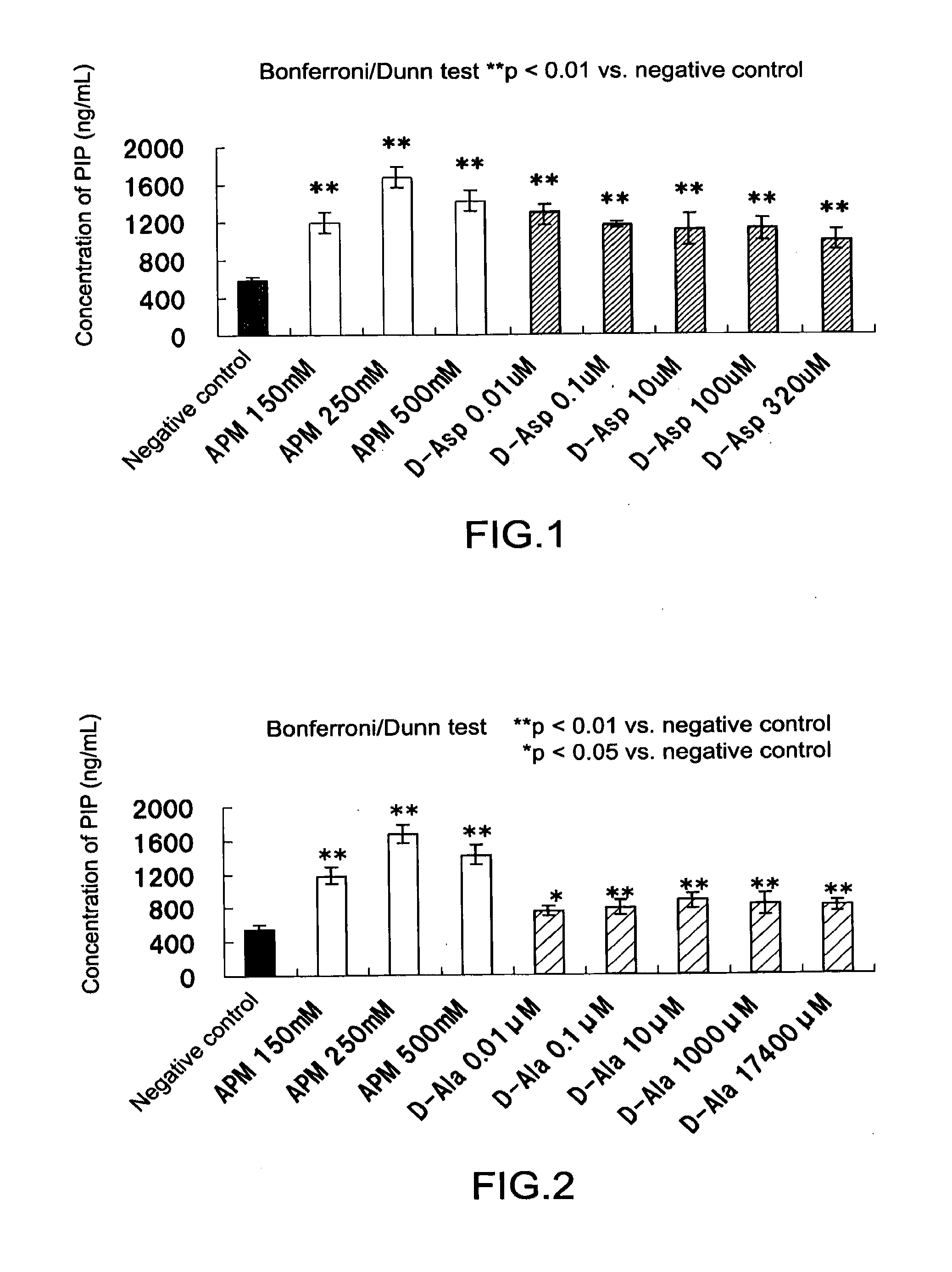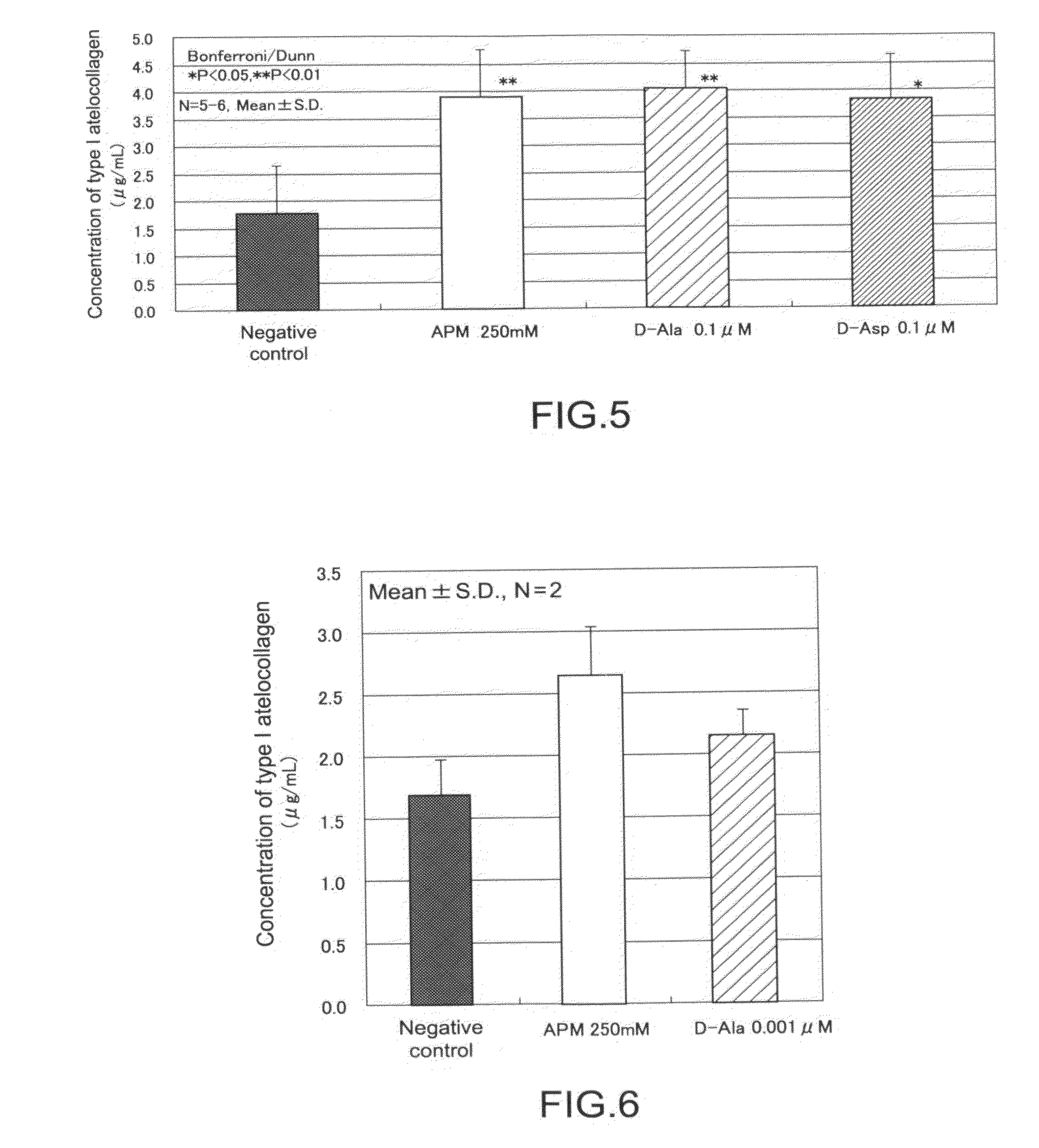Composition for promoting collagen production
a collagen and composition technology, applied in the field of collagen compositions, can solve the problems of easy decomposition of retinoids, and achieve the effect of promoting collagen production and high photostability
- Summary
- Abstract
- Description
- Claims
- Application Information
AI Technical Summary
Benefits of technology
Problems solved by technology
Method used
Image
Examples
example 1
Collagen Production Promoting Effect of D-Aspartic Acid Methods
[0044]Cell Culture
[0045]Commercially available human neonatal dermal fibroblasts (Cryo NHDF-Neo, manufactured by Sanko Junyaku Co., Ltd.) were used. The cells were inoculated in a commercially available 24-well plate to have 2×105 cells per well. The cells were then cultured for four hours in a commercially available medium for cell culture (D-MEM (1 g / L glucose), manufactured by Wako Pure Chemical Industries, Ltd.) to which 10% bovine fetal serum was supplemented (herein below, referred to as a “standard medium”) in a 5% CO2 and saturated water vapor atmosphere at 37° C. (degrees Celsius).
[0046]Addition of Amino Acids
[0047]Subsequently, the medium was switched to a commercially available medium for cell culture (D-MEM (1 g / L glucose), manufactured by Wako Pure Chemical Industries, Ltd.) supplemented with 0.5% bovine fetal serum (herein below, referred to as “low-serum medium”) and cultured for approximately one day in a...
example 2
Effect of Promoting Collagen Production of D-Alanine Methods
[0053]The cell culture, addition of amino acids, and quantification of production amount of type I collagen were carried out in the same manner as the Example 1. As an amino acid, D-alanine (manufactured by Peptide Institute, Inc., 2801) was used at the concentrations of 0.01 μM (micro-molar), 0.1 μM (micro-molar), 10 μM (micro-molar), 1000 μM (micro-molar), and 17400 μM (micro-molar). Further, the low-serum medium described above to which neither APM nor D-alanine had been added was employed as a negative control.
[0054]Quantification Results
[0055]FIG. 2 shows the results of experiment examining the effect of adding D-alanine on type I collagen production in human neonatal dermal fibroblasts. The error bars for each experimental condition indicate the standard deviations of experimentally measured values obtained by repeating the experiment four to six times under the identical condition. The asterisk (*) indicates that p i...
example 3
Effect on Promoting Collagen Production of L- and D-Aspartic Acid
[0057]Methods
[0058]The cell culture, addition of amino acids, and quantification of production amount of type I collagen were carried out in the same manner as the Example 1. D-Aspartic acid (manufactured by Wako Pure Chemical Industries, Ltd., 018-04821) of 0.1 μM (micro-molar) and L-aspartic acid (manufactured by Wako Pure Chemical Industries, Ltd., 013-04832) of 0.1 μM (micro-molar) were used as amino acids. Further, the low-serum medium described above to which neither L-aspartic acid nor D-aspartic acid had been added was employed as a negative control.
[0059]Quantification Results
[0060]FIG. 3 shows the results of experiment examining the effect of adding L- and D-aspartic acid on the type I collagen production in human neonatal dermal fibroblasts. The error bars for each experimental condition indicate the standard deviations of experimentally measured values obtained by repeating the experiment six to twelve time...
PUM
| Property | Measurement | Unit |
|---|---|---|
| body weight | aaaaa | aaaaa |
| body weight | aaaaa | aaaaa |
| concentration | aaaaa | aaaaa |
Abstract
Description
Claims
Application Information
 Login to View More
Login to View More - R&D
- Intellectual Property
- Life Sciences
- Materials
- Tech Scout
- Unparalleled Data Quality
- Higher Quality Content
- 60% Fewer Hallucinations
Browse by: Latest US Patents, China's latest patents, Technical Efficacy Thesaurus, Application Domain, Technology Topic, Popular Technical Reports.
© 2025 PatSnap. All rights reserved.Legal|Privacy policy|Modern Slavery Act Transparency Statement|Sitemap|About US| Contact US: help@patsnap.com



